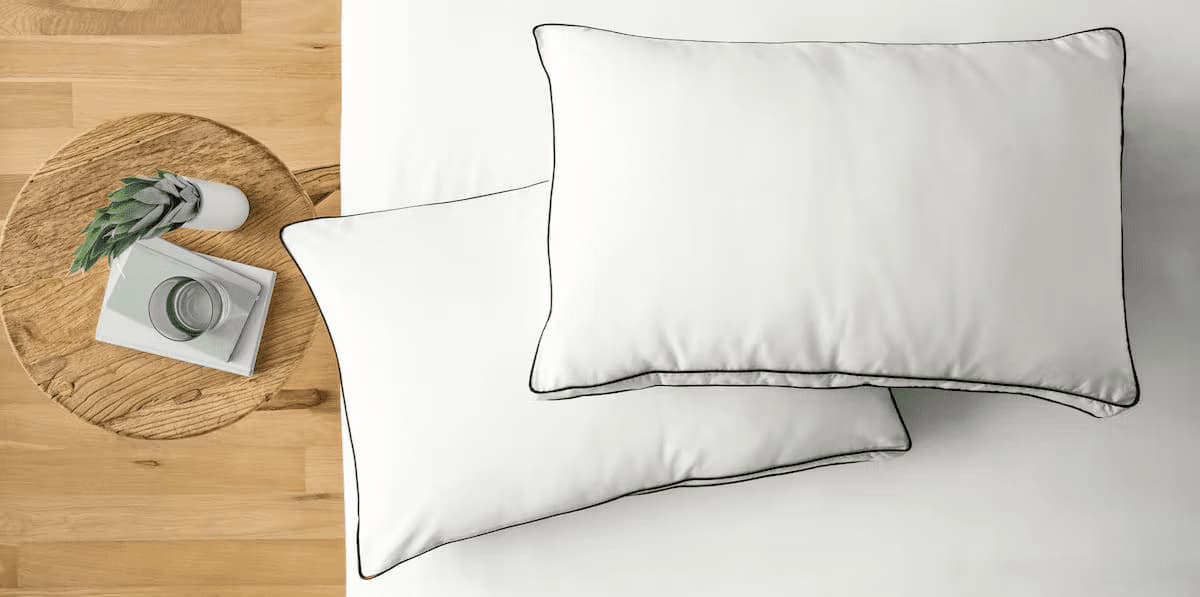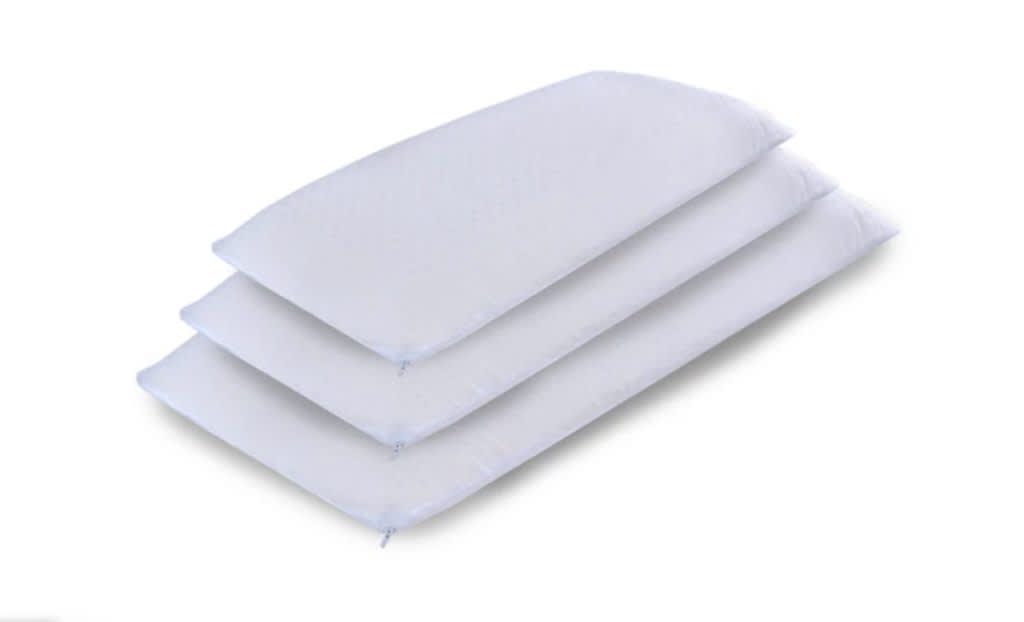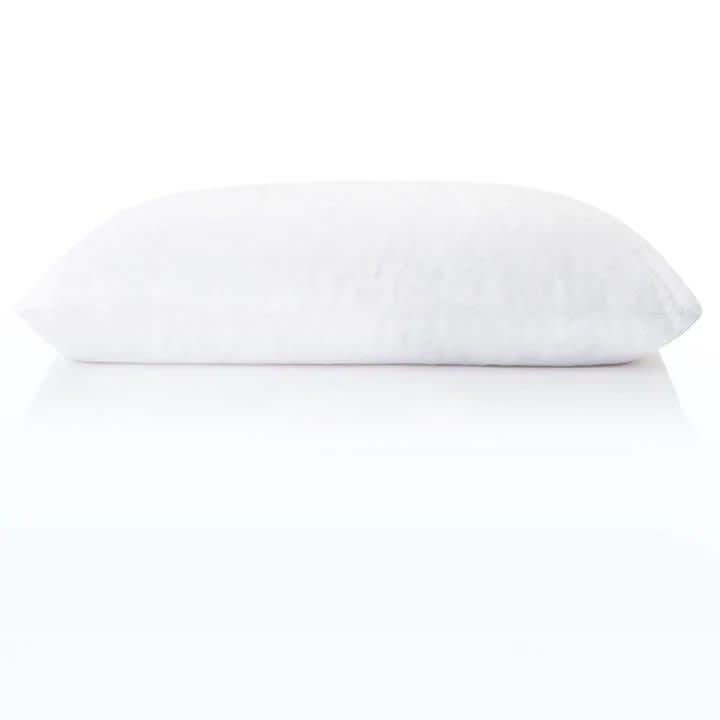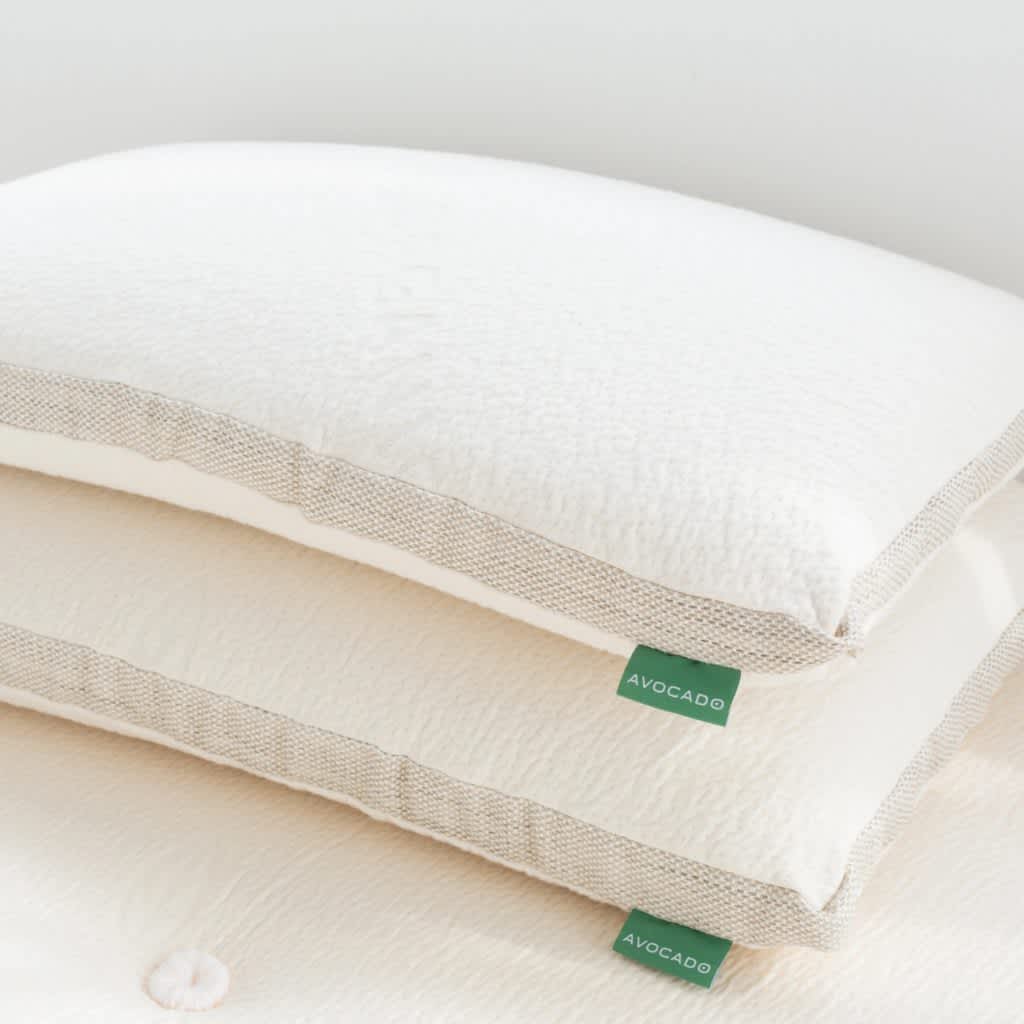On This Page
The Best Latex Pillows of 2025
Our Top Picks
-
Best Overall Pillow
Saatva Latex Pillow -
Best Pillow for Side Sleepers
Turmerry Organic Latex Pillow -
Most Comfortable Pillow
PlushBeds Organic Shredded Latex Pillow -
Best Luxury Pillow
Avocado Green Pillow
Best Overall Pillow
Highlights
Highlights
- Heat-wicking organic cotton cover
- A removable inner pillow to customize loft
- Responsive and breathable Talalay latex core
Ideal For
- Sleepers who need extra head and neck support
- People with allergies or sensitive skin
- Shoppers who value organic materials
Full Details
Best Pillow for Side Sleepers
Highlights
Highlights
- Available in two lofts and three firmness levels
- Solid Dunlop latex core offers excellent support
- A zippered organic cotton cover
Ideal For
- Side sleepers sensitive to allergens
- Shoppers wanting different loft and feel options
- Those who prefer natural and organic materials
Full Details
Most Comfortable Pillow
Highlights
Highlights
- Fluffy and moldable design
- Shredded latex core boosts airflow
- Certified organic materials
Ideal For
- Sleepers who like to mold their pillow
- People who tend to sleep hot
- Stomach, back, side, and combination sleepers
Full Details
Best Luxury Pillow
Highlights
Highlights
- Machine-washable organic cotton cover
- Breathable and eco-friendly blend of latex and kapok fibers
- Adjustable loft
Ideal For
- Those who like moldable pillows
- Sleepers under 230 pounds
- Shoppers who prioritize sustainable products
Full Details
How We Test Pillows
We test pillows against the same set of strict standards that we use for other pillow types, but we pay close attention to several factors that set different pillows apart. In addition to firmness, conforming, and ease of cleaning, we also measure breathability. Many sleepers choose specific materials for their cool feel. To determine how well a pillow regulates temperature, we use thermal sensors that measure heat retention and we try them ourselves too, taking notes on how warm or cool we think a pillow feels after use.
What Is Latex?
Natural latex is derived from the sap of rubber trees and manufactured using the Dunlop or Talalay method. Bedding companies may use synthetic latex, which is made from petrochemicals. Some manufacturers also incorporate a blend of natural and synthetic latex.
Latex pillows are known for their contouring and firm support. They are very responsive and maintain their shape over time. Latex is also breathable, especially when compared to most foams.
A latex pillow’s feel and support depends on the construction. For example, solid latex cores are sturdier, while shredded latex pillows are more pliable and offer exceptional airflow.
Solid latex and shredded latex have pretty different feels. They’re both breathable and pressure relieving, but shredded latex is much more conforming and moldable than solid latex.
Dunlop vs. Talalay
Natural latex is extracted from the sap of rubber trees and then manufactured using the Dunlop or Talalay method. The two techniques create distinct latex qualities.
Dunlop Latex
Sap is frothed, poured into a mold, and then baked during the Dunlop process. Sediment collects at the bottom of the mold, creating a denser type of latex. Dunlop products tend to be very firm and durable.
Talalay Latex
In the Talalay method, frothed sap is vacuum-sealed in a mold, frozen, and then baked. The result is a lighter, more uniform texture. Talalay latex products have notable airflow and responsiveness.
Latex vs. Memory Foam
Both latex and memory foam conform to the body and alleviate pressure buildup. Memory foam offers a deeper hug, while latex provides moderate contouring. Latex has a more responsive feel and returns to its original shape quicker than memory foam.
While the two materials are generally quite durable, memory foam is more vulnerable to sagging over time. Due to its durability and manufacturing process, latex tends to be more expensive than memory foam.
The biggest difference between the two materials is temperature control. Memory foam tends to trap heat, which can be problematic for hot sleepers. Latex, however, is more successful at preventing heat retention. Talalay latex retains even less heat, as it has a lower density than Dunlop latex. Shoppers that prioritize natural materials also tend to favor latex over memory foam.
Latex Pillow
Who Is a Latex Pillow Best For?
Every sleeper has different pillow needs when it comes to support and comfort. An ideal pillow depends on body type, sleep position, and personal preferences.
Whether you opt for a latex pillow or a different style, it’s important that your pillow encourages proper spinal alignment. Side and back sleepers and those with neck pain often benefit from a latex pillow’s firm support. However, a latex pillow that is very thick or dense can distort spinal alignment for stomach sleepers.
While many manufacturers claim their pillow is hypoallergenic, people with latex allergies should still avoid latex pillows.
We’ll discuss which types of sleepers are most likely to benefit from a latex pillow.
Side Sleepers
Side sleepers need a supportive pillow that minimizes the gap between their neck and mattress. Latex pillows typically achieve this since they’re relatively dense and have a higher loft. Side sleepers who switch to latex pillows often find that they no longer need to fold their pillow in half to generate extra loft.
Back Sleepers
Back sleepers generally do well with a moderately firm, medium-loft latex pillow. This combination keeps the spine level for most back sleepers over 130 pounds. Back sleepers under 130 pounds don’t sink as deeply into the mattress, so they require a higher loft pillow to maintain neutral spine alignment.
Those With Neck Pain
Pillows that lack support can cause neck pain. A sturdy latex pillow can prevent or minimize tension by enforcing good cervical alignment.
Hot Sleepers
As a naturally breathable material, latex is a good choice for people who tend to sleep hot. Shredded latex pillows have excellent airflow, but solid latex models sleep cooler than most memory foam, polyester, and down pillows.
How to Pick a Latex Pillow
Sleep comfort differs on an individual basis and depends on many factors. While there isn’t a perfect pillow that satisfies every sleeper, some styles work with certain sleep positions and body types better than others.
Adjustable models can be helpful for sleepers who don’t know what type of pillow offers the best support for their needs. Some shredded latex pillows have zippered covers that allow users to add or remove fill, which makes it easy for sleepers to experiment with different lofts and feels. Adjustable models are also a good solution for people whose preferences change over time.
I think if you’re in the market for an eco-friendly pillow that’s going to last a long time, organic latex is a great option. Latex pillows hold their shape really well and can last up to 10 years if you care for them correctly.
What Kind of Support Do You Need?
Latex conforms to the body yet doesn’t compress as much as other materials. As such, latex pillows encourage head and neck alignment while preventing pressure points from forming.
With a sturdy design, latex pillows are a good choice for sleepers who need extra support. People with chronic neck pain and sleepers over 230 pounds can benefit from their relatively dense cores.
Shoppers should consider their sleep position, body type, and support needs when choosing a latex pillow. For example, our testing revealed that side sleepers over 230 pounds feel most supported on a solid Dunlop model.
What Is the Best Pillow Loft?
Loft indicates a pillow’s relative height. Since your pillow’s loft determines how elevated your head is, it plays a critical role in support and neck alignment.
Pillows that are less than 3 inches are considered low loft. Medium-loft pillows are 3 to 5 inches, and high-loft models are taller than 5 inches.
The right loft for you largely depends on your sleep position.
How Firm Should Your Latex Pillow Be?
A pillow’s firmness refers to how well it holds its shape under weight and pressure.
Pillows range from soft to firm, with the former flattening more readily than the latter. Most latex pillow firmness levels range from medium to firm.
Similar to loft, every sleeping position has different firmness needs when it comes to support and pressure relief.
What Should You Know Before Buying a Latex Pillow?
Sleeping position, firmness level, and loft are important factors to consider when determining what type of pillow is right for you. Shoppers should also look at a pillow’s cost, durability, and care guidelines before purchasing.
How Much Does a Latex Pillow Cost?
Latex pillows tend to be more expensive than models made from polyester, fiber, and memory foam. That said, prices vary considerably depending on the brand, workmanship, and type of latex used. While budget designs may cost $40, shoppers can easily spend upwards of $200 on a luxury model. Cost usually increases with size, and adjustable models tend to be more expensive. Organic latex pillows typically command a higher price-point.
How Long Does a Latex Pillow Last?
Most latex pillows should last at least five years, assuming sleepers properly care for them. A high-quality model can easily maintain its shape and support for 10 years. Sleep style, body size, cleaning habits, and pillowcase use can impact how long your pillow lasts. Following the manufacturer’s care guidelines is one of the best ways to extend your pillow’s lifespan.
If you notice uneven support or experience new neck or shoulder pain, it may be time to replace your pillow. While latex pillows retain their shape longer than most types, they do flatten given enough time.
How to Care for a Latex Pillow
Since care instructions vary, it’s important to refer to the product label before washing your pillow. Most latex pillows can be spot-treated with water and mild soap. The latex pillow itself is rarely machine-washable, but some models can be professionally dry cleaned. Some removable covers can be washed by machine.
Fluffing by hand typically refreshes a shredded latex pillow, but some pillows are safe to tumble dry on low. Prolonged sun exposure can degrade latex, so shoppers should keep their pillow away from direct sunlight.
Explore More Pillows
If you’re looking for a particular type of pillow, check out our other guides below.




